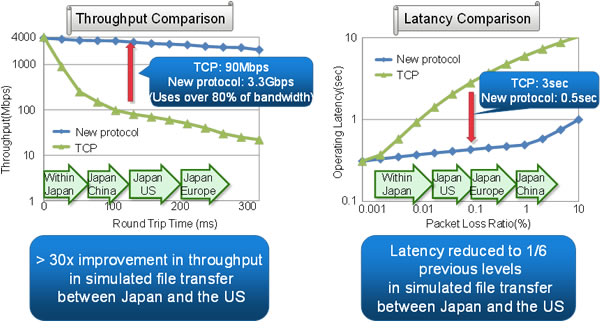Fujitsu Laboratories Limited today announced the development of a new data transfer protocol that, by taking a software-only approach, can significantly improve the performance of file transfers, virtual desktops and other various communications applications.
Through a simple software installation, the new technology will make it possible to speed up TCP applications that previously required costly specialized hardware, and it can also be easily incorporated into mobile devices and other kinds of equipment. Moreover, compared with TCP, the technology enables a greater than 30 times improvement in file transfer speeds between Japan and the US, in addition to reducing virtual desktop operating latency to less than 1/6 of previous levels. During fiscal 2013, Fujitsu Laboratories aims to commercialize the new technology as a communications middleware solution for improving communications speeds without having to modify existing TCP applications.
Conventionally, when using transmission control protocol (TCP)(1)—the standard protocol employed in communications applications—in a low-quality communications environment, such as when connected to a wireless network or during times of line congestion, data loss (packet loss) can occur, leading to significant drops in transmission performance due to increased latency from having to retransmit data.
To address this problem, Fujitsu Laboratories has succeeded at a software-only approach, developing: 1) A new protocol that incorporates an efficient proprietarily developed retransmission method based on user datagram protocol (UDP)(2), an optimized way to deliver streaming media able to reduce latency resulting from data retransmission when packet loss occurs; 2) Control technology that addresses the problem of UDP transmissions consuming excess bandwidth by performing a real-time measurement of available network bandwidth and securing an optimal amount of communications bandwidth without overwhelming TCP’s share of the bandwidth; and 3) Technology that, by employing the new protocol, makes it possible to easily speed up existing TCP applications without having to modify them.
2) Communications bandwidth control technology using real-time measurement of available network bandwidth
Fujitsu Laboratories developed a control technology that, by performing real-time measurement of available network bandwidth, can secure an optimal amount of communications bandwidth without overwhelming the share of bandwidth used by other TCP communications in a mixed TCP environment. For example, when other TCP communications are using relatively little bandwidth, the bandwidth share for the new protocol will increase, and when other TCP communications are taking up a higher percentage of bandwidth, the new protocol will use a smaller share.
3) Technology for accelerating existing TCP applications without any modifications
Fujitsu Laboratories has developed a technology that automatically converts TCP traffic standard for a wide variety of applications into the new protocol described in (1) above. This makes it possible to significantly improve the speed of a host of existing applications, including file transfer applications, virtual desktop applications, and web browsing applications, all without the need for any modifications.
Results
The use of the new technology is expected to speed up the performance of a wide range of communications applications employing international communication lines and wireless networks which are anticipated to become widely used more and more. For instance, the technology can help speed up web browsing and file download speeds in mobile communications environments where there is deterioration due to building obstructions or movement. In addition, the technology can improve data transfer speeds between datacenters in Japan and the US. It is also expected to help improve the usability of virtual desktops when accessing a virtual desktop located on a remote server using a low-quality communications environment.
If you liked this article, please give it a quick review on ycombinator or StumbleUpon. Thanks

Brian Wang is a Futurist Thought Leader and a popular Science blogger with 1 million readers per month. His blog Nextbigfuture.com is ranked #1 Science News Blog. It covers many disruptive technology and trends including Space, Robotics, Artificial Intelligence, Medicine, Anti-aging Biotechnology, and Nanotechnology.
Known for identifying cutting edge technologies, he is currently a Co-Founder of a startup and fundraiser for high potential early-stage companies. He is the Head of Research for Allocations for deep technology investments and an Angel Investor at Space Angels.
A frequent speaker at corporations, he has been a TEDx speaker, a Singularity University speaker and guest at numerous interviews for radio and podcasts. He is open to public speaking and advising engagements.



